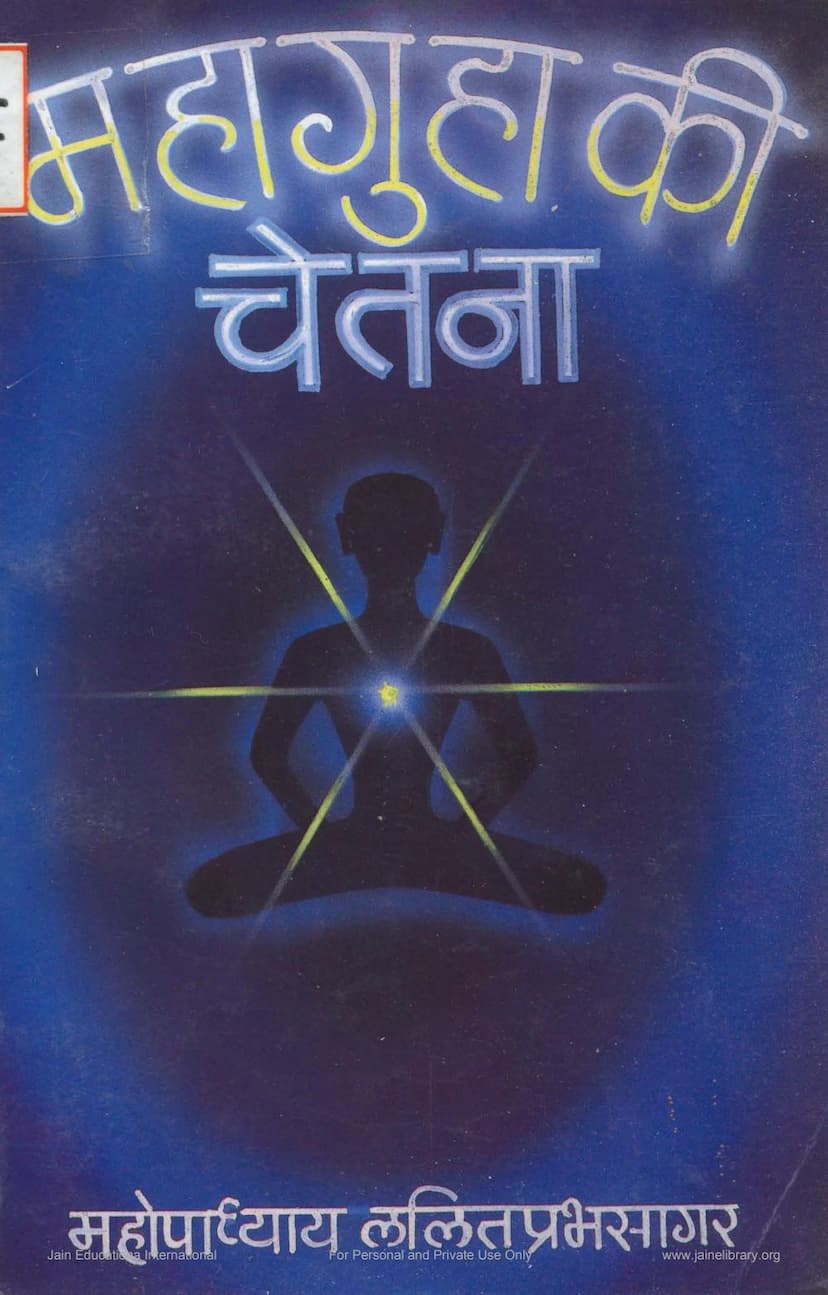Mahaguha Ki Chetna
Added to library: September 2, 2025

Summary
Here's a comprehensive summary of the Jain text "Mahaguha ki Chetna" (The Consciousness of the Great Cave) by Mahopadhyay Lalitprabh Sagar, based on the provided pages:
Book Overview:
"Mahaguha ki Chetna" is a collection of spiritual discourses and commentary by Mahopadhyay Lalitprabh Sagar, focusing on the profound "Sambodhi-Sutra." The book is presented as an entryway for spiritual seekers to the path of self-realization, with meditation as the method and spiritual absorption (samadhi) as the goal. The author emphasizes that true meditation is a science of detaching from the world while living within it, leading from a state of unconsciousness (murcha) towards wisdom (prajna).
Core Themes and Concepts:
- The Inner Sky (Antas ka Akash): This is a central metaphor, representing the vast, infinite space within oneself. True spiritual journey begins by exploring this inner realm.
- The Nature of the Mind: The mind is described as a "lava of unbridled tendencies" and the "master of fluctuations." The initial challenge in inner exploration is the mind itself. However, by developing a "witnessing attitude" (drasta-bhav) and "observational attitude" (sakshi-bhav), the mind can become an ally. The advice is to observe thoughts without judgment, separating oneself from their flow.
- "Who Am I?" (Main Kaun Hun?): This fundamental question is the starting point and the ultimate goal of spiritual practice. The Sambodhi-Sutra is presented as a key to unlocking the mysteries of one's spiritual life and understanding one's true identity.
- Meditation (Dhyan) as the Path: Meditation is consistently highlighted as the core practice for inner exploration. It's the "way of ways" and the means to realize "who is within." It's an inward journey essential for self-awareness and achieving self-realization.
- Detachment from the World (Vairagya/Nisprhahata): While living in the world, one must cultivate detachment from its worldly attractions and attachments. The story of Ranka and Banka illustrates the idea that true detachment comes from seeing the ephemeral nature of worldly possessions, symbolized by Ranka trying to cover gold coins with mud.
- The Significance of the Present Moment (Vartaman): The book stresses the importance of living in the present, observing the breath, and not getting lost in past memories or future imaginations. The present moment is where true life and spiritual progress occur.
- "Sambodhi" (Complete Understanding/Enlightenment): This refers to the attainment of self-knowledge, complete understanding, and the joy derived from it. It's described as a "shower of Sambodhi," leading to deep inner peace.
- The True Nature of the Self: The self is eternal and unchanging, distinct from the physical body and even the mind and thoughts. The practice of meditation helps to realize this eternal essence.
- Karma and Liberation (Moksha): The book touches upon the concept of karma and how meditation can help in shedding karmic bonds. Liberation is an inherent right of all beings.
- The Role of the Sadguru: A true spiritual teacher (Sadguru) acts as a beacon, illuminating the path, guiding the seeker, and helping them overcome internal darkness and illusions. They are like a lighthouse or a guide who points towards the moon (truth) without attaching oneself to the finger pointing.
- The Importance of Inner Transformation: Outer changes like renouncing the world or adopting specific rituals are less important than the inner transformation of one's attitudes, thoughts, and consciousness.
- The "Sambodhi-Sutra": This sutra itself is described as a divine creation, not written but spontaneously emerged from inner joy and the "great emptiness" of consciousness. It's considered the "silence of Mahavir" and the "dance of Mira."
Key Chapters/Discourses (as indicated by titles):
- The Inner Sky (Antas ka Akash): The starting point of the spiritual journey, the exploration of the inner self.
- The World in One's Arms (Banhon Bhar Sansar): Discusses attachment and detachment, and how the concept of "mine" and "yours" creates worldly bondage.
- All Seven Days Belong to God (Saaton Din Bhagwan ke): Emphasizes consistent spiritual effort and the importance of living every day in devotion and mindfulness, rather than postponing spiritual practices.
- The Body as a Bamboo Flute (Kaya Murli Bans ki): Explores the potential of the human body as an instrument for divine music when hollowed out and played by the divine breath (consciousness).
- Transform the Mind, Transform the Body (Karein, Man Ka Kayakalp): Focuses on the power of the mind and its transformation for a better life.
- Recognize Your Own Brahman (Pehchanein, Nij Brahm ko): Highlights the importance of self-discovery and realizing the divine within.
- The Sadguru Distributes Light (Sadguru Baante Roshni): Explains the role of a spiritual guide in dispelling ignorance and illuminating the path.
- Liberation is the Right of All Beings (Muktih Pranirnatra ka Adhikar): Asserts that liberation is an inherent birthright, achievable through inner work.
- The Witnessing Attitude: The Basis of Meditation (Sakshi-bhav: Dhyan ka Aadhar): Underlines the foundational importance of the witnessing attitude for successful meditation.
- The Expansion of Love (Prem ka Vistar): Discusses the need to expand love beyond personal confines to embrace all existence.
- Be a Witness to the Present (Sakshi Hon Vartaman ke): Reaffirms the necessity of living consciously in the present moment.
- A Peaceful Mind is Meditation (Shant Manas hi Sadhana): Concludes that a tranquil mind is the essence and outcome of true spiritual practice.
Overall Message:
The book is a profound guide for those seeking spiritual enlightenment. It advocates for a deep inner journey, emphasizing self-observation, detachment, mindfulness, and the transformative power of meditation under the guidance of a Sadguru. It encourages readers to realize their innate divine potential and live a life of peace, love, and ultimate liberation. The Sambodhi-Sutra is presented as a powerful tool and a source of inspiration for this spiritual quest.